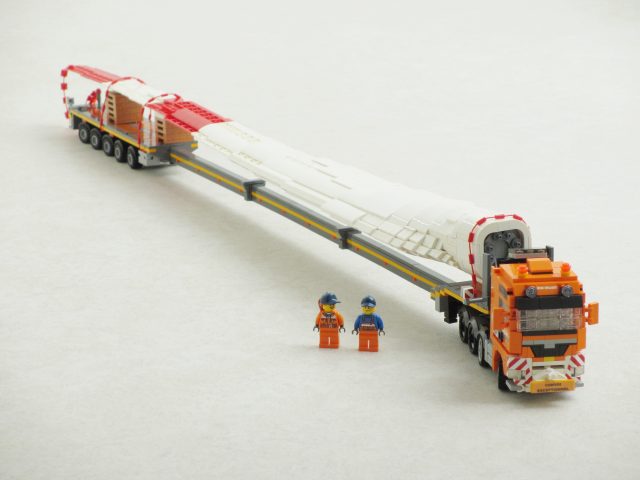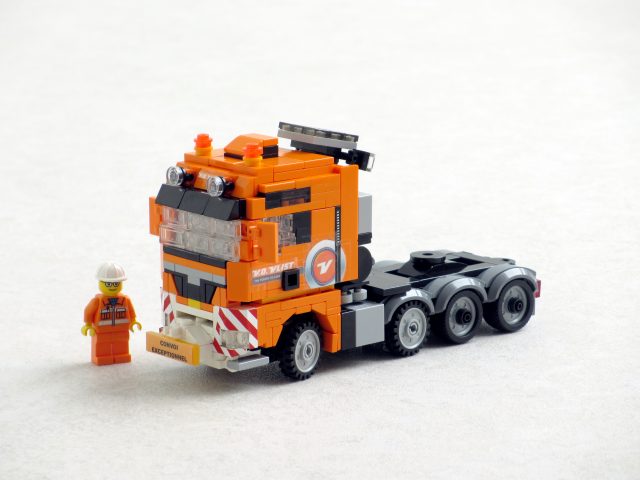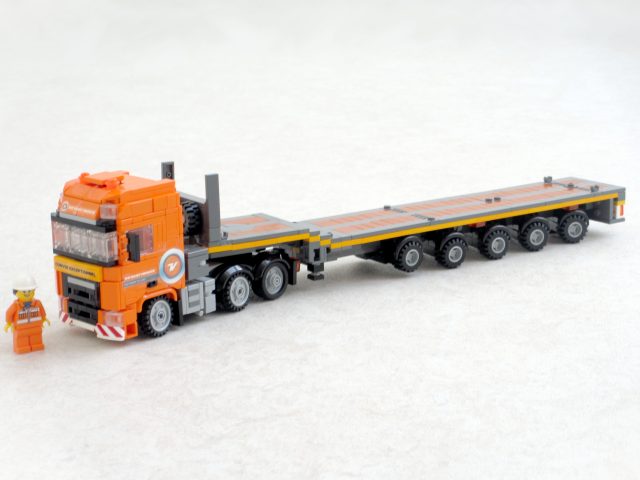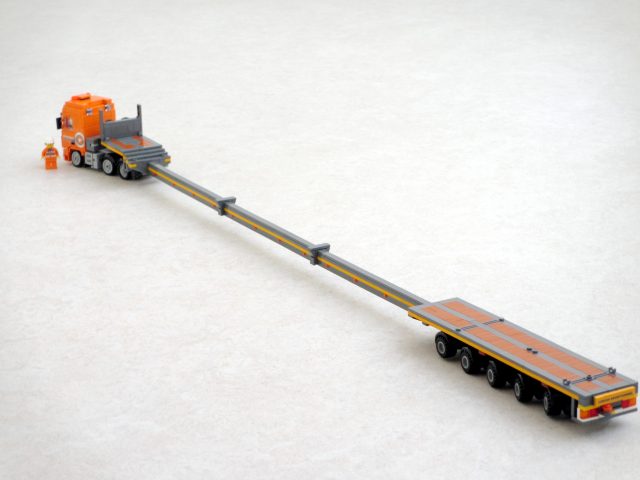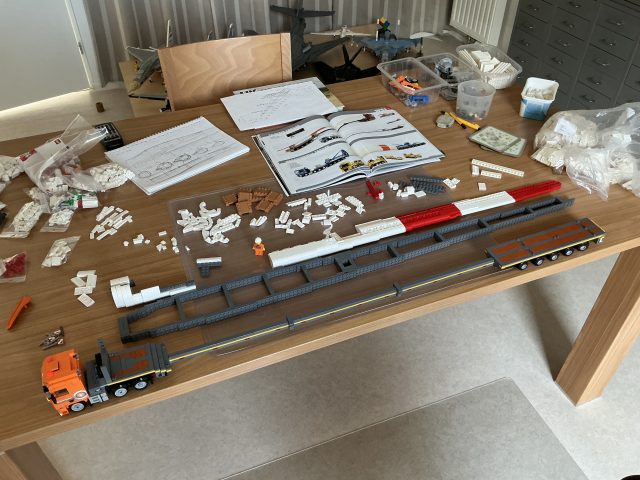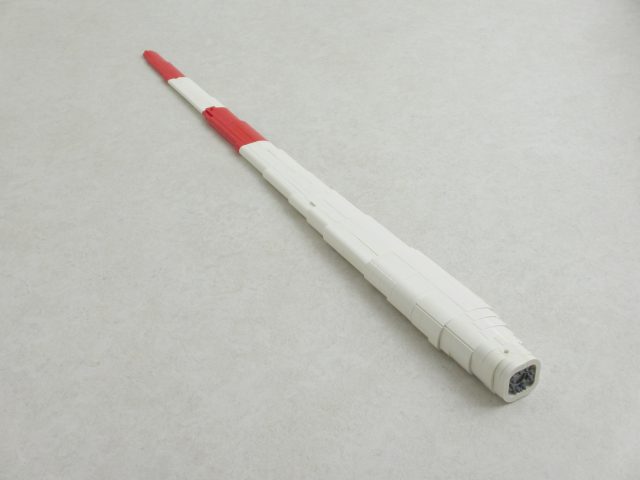When I built my Lego mega windmill trailer, for carrying a wind turbine nacelle, I did not think this would be the start of a trilogy. However, I subsequently built a truck that carries a rotor hub. At that point, it was pretty much inevitable that I would also build a vehicle carrying one of the blades.
I put this off for more than two years, though, because I did not relish building the blade. The nacelle represents a Vestas V90 wind turbine. By now, this is something of an old clunker, and it is quite small compared to more modern turbines. Nonetheless, its blades are still 44 m long. This makes them 128 studs long at the scale of my other vehicles (1/43). And I happen to like building small details. This is one reason why I enjoy building minifigure-scale trucks so much. By comparison, the blade’s size and its complicated shape would make building it pretty tedious. And it was tedious, indeed. However, the finale to my wind turbine trilogy is one of the most beautiful shapes I have ever built.
The tractor is a German-built MAN TGX in the orange livery of Dutch heavy haulage firm Van der Vlist. This is essentially a copy of the train truckers tractor from earlier this year, in a different colour and with a few different details. When I built this, in the summer, I had no intention of building a trailer for it. I lent the Volvo that pulls the mega windmill trailer to a friend and simply wanted a suitable tractor to replace it on my display shelves. Since Van der Vlist also uses MANs for this task and I had the parts I needed to build one, building one made sense.
Of course, I will eventually get the Volvo back. And Van der Vlist uses Volvos for pulling trailers with wind turbine blades. The writing was on the wall: I simply had to build a trailer and a wind turbine blade. I could not put it off any longer. The so-called Telestep trailer is built by the Dutch manufacturer Nooteboom. It consists of a front end that attaches to the tractor’s fifth wheel, a rear end with the trailer’s axles, and a telescopic boom that connects them. I have standardised my trailer connections, so this also fits my older DAF tractor. If the trailer is empty or carries only a short load, the telescopic boom is retracted.
For carrying longer loads, the boom extends. I cannot make a telescopic boom that is long enough and sufficiently sturdy at this small scale. Instead, I built a solid boom using stacked plates. I designed the connections to the front and rear trailer sections such that I can easily remove it. Carrying the blade does not require the trailer’s full length, but it is still 122 studs long, with an 80-stud beam. Obviously, its turning radius is astronomical, even though four of the trailer’s five axles have steering. On my model, these are functional, with a mechanism that connects them such that they have different steering angles.
With the trailer done, it was time to build the blade. I carefully studied photographs and diagrams of turbine blades. Windmills work because, due to the wind interacting with the blades’ airfoil shape, a pressure differential forms between the blades’ upper and lower surfaces. This results in a force acting on the blades. This creates torque on the rotor hub, turning the rotor and driving a generator. For structural reasons and because the tip of the blade moves at a different speed relative to the wind, the shape of the airfoil changes gradually along the length of the blade. It starts off being round near the hub. It then becomes teardrop-shaped and finally it flattens. So, it gets thinner and narrower, all with nice sweeping curves. The trailing edge has a particularly complicated curved shape.
All of this made building it a challenge. Before building the actual blade, I built a rough outline, to use as a template. I then built the connection point to the hub, and then gradually built the rest of the blade, moving from the tip towards the hub. I built most of the structure outside-in, working out the outer shape and then figuring out the internal structure required to make it sufficiently strong. This was tedious, as expected, but I simply ploughed on. It took about twelve hours of building and the result looks beautiful.
One way to transport the blade is with it lying flat on top of the trailer, supported by wooden pallets. However, although the blade is fairly strong, it is also heavy. When I first put it on top of the truck, I feared I was in trouble because the whole trailer bent. Without a load, the boom that connects both trailer ends sags only a bit. The weight of the blade resting on the pallet at the front of the trailer’s rear section was too much, though. Luckily, there was an easy fix for this. I attached the pallets to the trailer, using stud connections, and I attached the blade to the pallets, also using studs. As a result, the blade itself helps to keep the trailer rigid. It actually sags less than without the load. My trilogy is complete, and once I get the Volvo back, I will swap the tractors and photograph the lot together.
